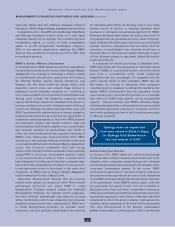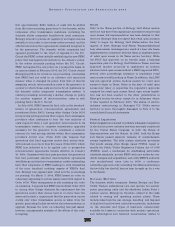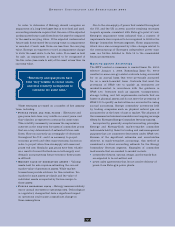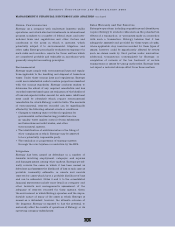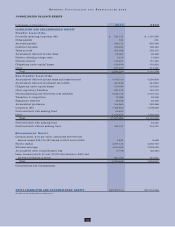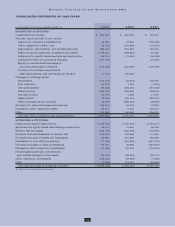Entergy 2003 Annual Report Download - page 46
Download and view the complete annual report
Please find page 46 of the 2003 Entergy annual report below. You can navigate through the pages in the report by either clicking on the pages listed below, or by using the keyword search tool below to find specific information within the annual report.
44
ENTERGY CORPORATION AND SUBSIDIARIES 2003
SFAS 143
Entergy implemented SFAS 143, “Accounting for Asset
Retirement Obligations,” effective January 1, 2003. Nuclear
decommissioning costs comprise substantially all of Entergy’s
asset retirement obligations, and the measurement and
recording of Entergy’s decommissioning obligations changed
significantly with the implementation of SFAS 143. The
most significant differences in the measurement of these
obligations are outlined below:
RECORDING OF FULL OBLIGATION - SFAS 143 requires
that the fair value of an asset retirement obligation be
recorded when it is incurred. This caused the recorded
decommissioning obligation in Entergy’s U.S. Utility
business to increase significantly, as Entergy had
previously only recorded this obligation as the related
costs were collected from customers, and as earnings
were recorded on the related trust funds.
FAIR VALUE APPROACH - SFAS 143 requires that these
obligations be measured using a fair value approach.
Among other things, this entails the assumption that
the costs will be incurred by a third party and will
therefore include appropriate profit margins and risk
premiums. Entergy’s decommissioning studies to date
have been based on Entergy performing the work, and
have not included any such margins or premiums.
Inclusion of these items increased cost estimates.
DISCOUNT RATE - SFAS 143 requires that these
obligations be discounted using a credit-adjusted,
risk-free rate. This resulted in significant decreases
in Entergy’s decommissioning obligations in the Non-
Utility Nuclear business, as this discount rate is higher
than the implicit rates utilized by Entergy in accounting
for these obligations through December 31, 2002.
The net effect on Entergy’s financial statements of imple-
menting SFAS 143 for the U.S. Utility and Non-Utility
Nuclear businesses follows:
For the U.S. Utility business, the implementation of
SFAS 143 for the rate-regulated business of the domestic
utility companies and System Energy was recorded as a
regulatory asset, with no resulting impact on Entergy’s
net income. Entergy recorded these regulatory assets
because existing rate mechanisms in each jurisdiction
are based on the original or historical cost standard that
allows Entergy to recover all ultimate costs of decom-
missioning existing assets from current and future
customers. As a result of this treatment, SFAS 143 is
expected to be earnings neutral to the rate-regulated
business of the domestic utility companies and System
Energy. Assets and liabilities increased by approximately
$1.1 billion in 2003 for the domestic utility companies
and System Energy as a result of recording the asset
retirement obligations at their fair values of $1.1 billion
as determined under SFAS 143, increasing utility plant
by $288 million, reducing accumulated depreciation by
$361 million and recording the related regulatory assets
of $422 million. The implementation of SFAS 143 for the
portion of River Bend not subject to cost-based ratemaking
decreased earnings by approximately $21 million net-of-
tax ($0.09 per share) as a result of a one-time cumulative
effect of accounting change. In accordance with
ratemaking treatment and as required by SFAS 71, the
depreciation provisions for Entergy’s utility subsidiaries
include a component for removal costs that are not asset
retirement obligations under SFAS 143. Approximately
6% of the U.S. Utility’s current depreciation rates, on a
weighted-average basis, represents a component for the
net of salvage value and removal costs.
For the Non-Utility Nuclear business, the implementation
of SFAS 143 resulted in a decrease in liabilities in 2003
of approximately $595 million due to reductions in
decommissioning liabilities, a decrease in assets of
approximately $340 million, including a decrease in
electric plant in service of $315 million, and an increase
in earnings of approximately $155 million net-of-tax
($0.67 per share) as a result of the one-time cumulative
effect of accounting change.
Also, Entergy’s 2003 earnings for the Non-Utility Nuclear
business increased by approximately $18 million after-tax
over 2002 because of the change in accretion of the liability
and depreciation of the adjusted plant costs. This effect will
gradually decrease over future years as the accretion of the
liability increases. Management expects that applying SFAS
143 post-implementation will have a minimal effect on
ongoing earnings for the U.S. Utility business.
IMPAIRMENT OF LONG-LIVED ASSETS
Entergy has significant investments in long-lived assets in
all of its segments, and Entergy evaluates these assets
against the market economics and under the accounting
rules for impairment whenever there are indications that
impairments may exist. This evaluation involves a signifi-
cant degree of estimation and uncertainty, and these esti-
mates are particularly important in Entergy’s U.S. Utility
and Energy Commodity Services segments. In the U.S.
Utility segment, portions of River Bend and Grand Gulf are
not included in rate base, which could reduce the revenue
that would otherwise be recovered for the applicable
portions of those units’ generation. In the Energy
Commodity Services segment, Entergy’s investments in
merchant generation assets are subject to impairment if
adverse market conditions arise.
MANAGEMENT’S FINANCIAL DISCUSSION AND ANALYSIS
continued








